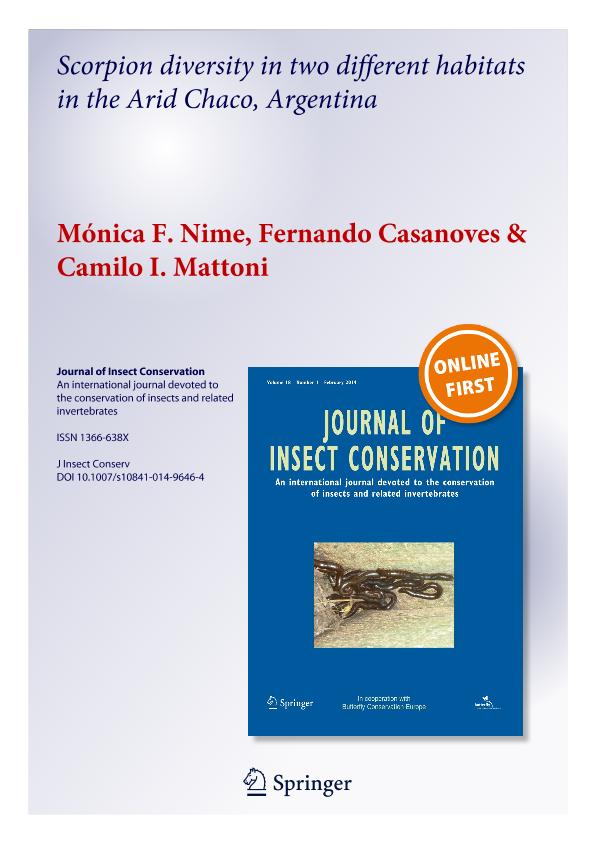Mostrar el registro sencillo del ítem
dc.contributor.author
Nime, Mónica Fernanda

dc.contributor.author
Casanoves, Fernando
dc.contributor.author
Mattoni, Camilo Ivan

dc.date.available
2016-11-04T17:44:24Z
dc.date.issued
2014-06
dc.identifier.citation
Nime, Mónica Fernanda; Casanoves, Fernando; Mattoni, Camilo Ivan; Surface activity, sex ratio and diversity of scorpions in two different habitats in an Arid Chaco reserve, Argentina; Springer; Journal Of Insect Conservation; 18; 3; 6-2014; 373-384
dc.identifier.issn
1366-638X
dc.identifier.uri
http://hdl.handle.net/11336/7988
dc.description.abstract
Scorpions are one of the most important taxa of predators in terms of density, biomass, and diversity in various areas of the world. In this study, we compared population- and community-level data between a mature and a secondary forest in the Chancaní Reserve (Córdoba, Argentina). Scorpions were collected using pitfall traps (54 nights per site), and their nocturnal activity was observed by means of UV light (26 nights per site) over 7 months. Seven species of scorpions (1964 individuals) were observed in the study area (Bothriuridae and Buthidae). Brachistosternus ferrugineus composed >74 % of all individuals and was numerically dominant in most months. It was the most common species sampled with UV light method in all months (85.73 % in mature and 81.80 % in secondary forest). Timogenes elegans was the most common species sampled with the pitfall traps method in secondary forest (48.58 %). General sex ratio (males:females) for B. ferrugineus was 1:1.24 and for T. elegans was 1:0.53. The Shannon index was not significantly different between sites. Species richness was similar, and the Jaccard index was Cs = 0.86, indicating that both sites share 86 % of the species. Tityus confluens was the only species not shared between sites. Our results indicate that species composition in regenerating forest resembles that of primary forest after c. 15 years, but the relative abundances of these species differ.
dc.format
application/pdf
dc.language.iso
eng
dc.publisher
Springer

dc.rights
info:eu-repo/semantics/openAccess
dc.rights.uri
https://creativecommons.org/licenses/by-nc-sa/2.5/ar/
dc.subject
Scorpiones
dc.subject
Arid Chaco
dc.subject
Mature Forest
dc.subject
Secondary Forest
dc.subject.classification
Ecología

dc.subject.classification
Ciencias Biológicas

dc.subject.classification
CIENCIAS NATURALES Y EXACTAS

dc.title
Surface activity, sex ratio and diversity of scorpions in two different habitats in an Arid Chaco reserve, Argentina
dc.type
info:eu-repo/semantics/article
dc.type
info:ar-repo/semantics/artículo
dc.type
info:eu-repo/semantics/publishedVersion
dc.date.updated
2016-11-02T18:12:30Z
dc.journal.volume
18
dc.journal.number
3
dc.journal.pagination
373-384
dc.journal.pais
Alemania

dc.journal.ciudad
Berlin
dc.description.fil
Fil: Nime, Mónica Fernanda. Consejo Nacional de Investigaciones Cientificas y Tecnicas. Centro Cientifico Tecnologico Cordoba. Instituto de Diversidad y Ecologia Animal; Argentina
dc.description.fil
Fil: Casanoves, Fernando. Consejo Nacional de Investigaciones CientiÂficas y Tecnicas. Centro Cientifico Tecnologico San Juan. Instituto de Ciencias Astronomicas de la Tierra y del Espacio; Argentina
dc.description.fil
Fil: Mattoni, Camilo Ivan. Consejo Nacional de Investigaciones Cientificas y Tecnicas. Centro Cientifico Tecnologico Cordoba. Instituto de Diversidad y Ecologia Animal; Argentina
dc.journal.title
Journal Of Insect Conservation

dc.relation.alternativeid
info:eu-repo/semantics/altIdentifier/url/http://link.springer.com/article/10.1007/s10841-014-9646-4
dc.relation.alternativeid
info:eu-repo/semantics/altIdentifier/url/http://dx.doi.org/10.1007/s10841-014-9646-4
Archivos asociados
